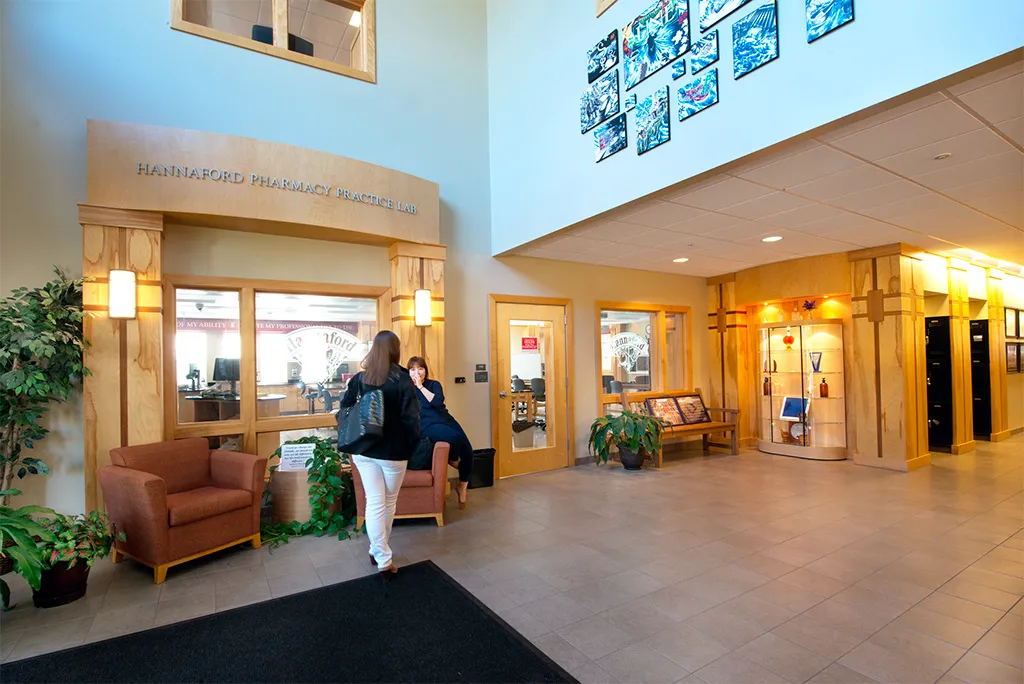Green Building Practices
From our multi-purpose student center, largest residence hall, athletics facility, and marine science center on the Biddeford Campus to our pharmacy building, Oral Health Center, and our currently-under-construction interprofessional health sciences center on the Portland Campus for the Health Sciences, UNE’s construction projects over the past 20 years have embodied our desire to lessen our campuses’ environmental impact. By incorporating environmentally responsible building practices, such as reusing excavated material and recycling as much construction waste as possible, by designing our buildings with the latest technology to be as energy efficient as they can be, and by upgrading and retrofitting our older buildings wherever we are able, we’re achieving our goal of greening the campus one building at a time.
Biddeford Campus
Ripich Commons
Named to honor former UNE President Danielle N. Ripich, the Ripich Commons, a three-level, multipurpose facility designed to support students’ everyday needs, boasts many innovative and ecologically sound features, including bird-safe glass, which was installed at the request of environmentally conscious undergraduates. The building was constructed with regionally sourced materials as well as materials with high recycled content, and it sports solar panels as the result of efforts by students in an Introduction to Environmental Studies class.
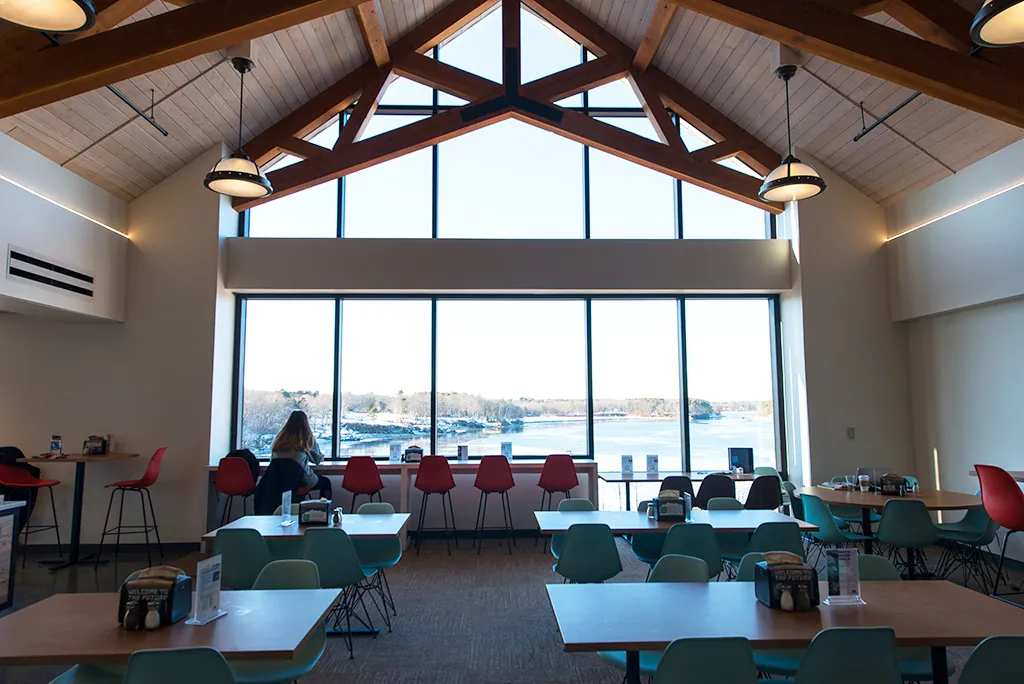
- Bird protection glass is used on the river-facing side of the building and in the skybridge to the library, composing 6,900 square feet of bird protection glass, which is 63% of the building’s total glass.
- Demand controlled kitchen ventilation in the dining hall employs innovative technology to adjust hood fan speeds depending on the cooking conditions of the appliances, saving up to 50% in energy costs.
- An innovative dishwasher system reduces water consumption and captures all compostable food scraps.
- The building is efficiently heated and cooled with water from the Biddeford Campus’ central heating and central chiller plants via four rooftop units that transfer the thermal energy from the central plants to the ventilation system.
- High efficiency motors, fans, variable speed drives, and pumps all contribute to energy efficiency by ramping up or down to meet the real-time needs of the building.
- Temperature sensors and automated controls provide air changes and temperature adjustments based on occupancy demand, minimizing the amount of heating or air conditioning required.
- A solar array on the side of the building converts the direct current electricity produced by the panels into alternating current electricity that can be used by the equipment in the building, thereby annually offsetting about 2.5 tons of carbon pollution that otherwise be produced.
- The building’s landscaping was designed to reduce and filter stormwater runoff by allowing water to seep through the paving stones and into the ground before reaching the Saco River, whose health is vitally important to thousands of people and hundreds of plant and animal species.
- Sustainable building materials were prioritized for the construction of the building and include over a dozen types of products that are certified for various aspects of sustainability, including tiles, cladding, acoustic insulation, roofing materials, flooring materials, and more.
Sokokis Hall
Built in 2010, Sokokis Hall is the largest of our residence halls, hosting a maximum of 300 upperclass students in suite-style living. With radiant floor heating, low-flow plumbing fixtures, and a sophisticated energy management system, it is the second of UNE’s two buildings that received silver level Leadership in Energy and Environmental Design (LEED) certification. The building’s landscaping showcases a pond that not only adds beauty and tranquility to the grounds but serves an important function in retaining storm water.
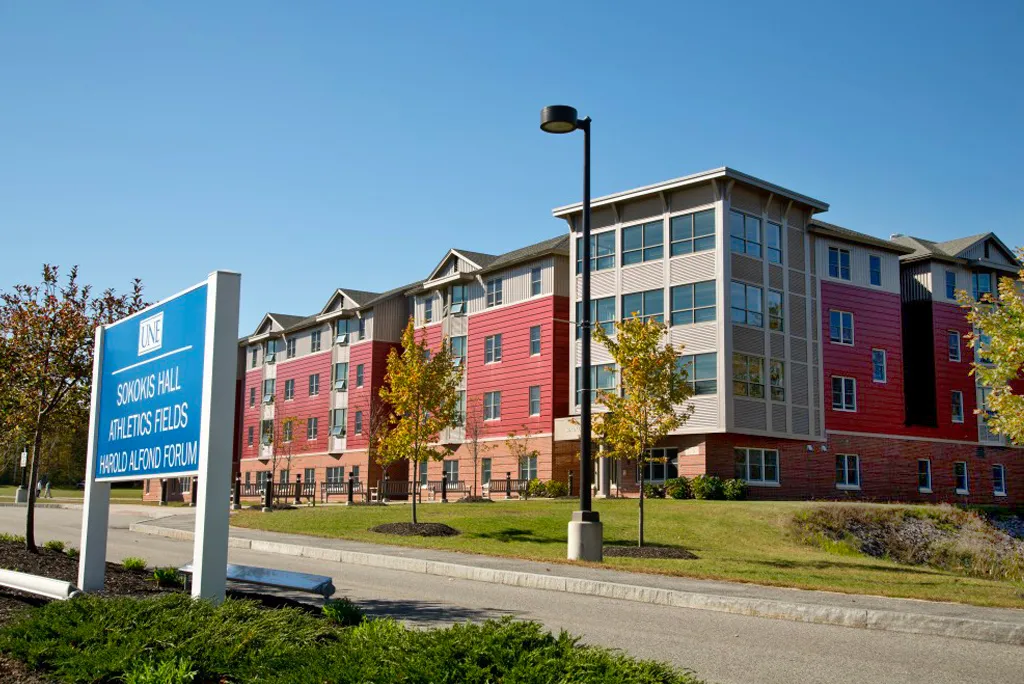
- Visible from the upper three floors’ study rooms, Sokokis Hall’s rear entrance and first floor student lounge sport a vegetated roof, blending with the outdoor environment and contributing to the thermal insulation of the building.
- 18.03% of the total building materials’ value includes materials and/or products that have been extracted, harvested, or recovered from locations within 500 miles of the project site.
- Potable water use is reduced by 33.7% from a calculated baseline through the installation of dual-flush water closets and low-flow lavatory faucets, showers, and kitchen sinks.
- All indoor adhesives, sealants, paints, coatings, and carpeting comply with low-emitting volatile organic compounds (VOC) limits of the referenced standards.
- 75% of the waste was diverted and recycled or salvaged during the demolition and construction phases, and 18.40% of the total building materials content, by value, has been manufactured using recycled materials.
- High-efficiency condensing boilers and radiant floor heating provide an efficient and steady thermal comfort to building occupants.
- Energy recovery units use the exhaust air to precondition the make-up air coming into the building, significantly reducing the fuel demand to heat or cool the supply air.
- The site design for Sokokis Hall involved attention to water use, incorporating a landscape plan that does not rely on irrigation and features an aesthetically pleasing stormwater retention pond.
- Building energy management systems adjust the ventilation and temperature provided to match the occupancy needs, thereby increasing efficiency and reducing waste.
Harold Alfond Forum
A 145,000-square-foot state-of-the-art athletics facility, the Harold Alfond Forum was built in 2012 and underwent an expansion in 2017. From its highly efficient Ice Kube system that reclaims heat from the process of producing ice for the hockey rink to its locker room ventilation system that utilizes “air cleaners” to limit exhaust flow and heat escape, the building is an example of environmental best practices for an athletics facility. Even the Zamboni used to maintain the ice and the truck used to paint the ice are fully electric vehicles. In 2024, UNE unveiled a 321.6-kilowatt solar array atop the Harold Alfond Forum, representing its largest and most visible investment in renewable energy to date.
Learn about the UNE Alfond Forum Solar Array Project
- The highly efficient Ice Kube system is used to make and maintain ice for the skating rink, reclaimed waste heat from the ice production and maintenance processes to heat the rink offices, skate rental space, and first floor lobby area through radiant floor heating.
- High-efficiency condensing boilers and radiant floor heating provide an efficient and steady thermal comfort to building occupants.
- High-efficiency motors, fans, variable speed drives, and pumps all contribute to energy efficiency by ramping up or down to meet the real-time needs of the building.
- Subsurface stormwater treatment and retention chambers were designed to limit environmental impact to the site.
- Polished concrete flooring reduced the need for carpeting or other floor finishes that require more impactful cleaning equipment and chemicals to maintain.
- Low-flow plumbing fixtures conserve water in the showers of the 18 locker rooms, laundry facilities and restrooms throughout the buildings.
- Locker room ventilation systems utilize “air cleaners” to limit exhaust flow and prevent heat from escaping the building, thereby reducing the need for fuel to continuously condition the locker room spaces.
- Solar film applied to windows limits solar heat gain, reducing the need for air conditioning in the summer.
- The ice rink uses and electric Zamboni to maintain the ice and a fully electric truck to paint the ice, resulting in a zero tailpipe emissions maintenance fleet.
Arthur P. Girard Marine Science Center
Offering 27,550 square feet of space, including five internal pools, wet and dry laboratories, offices, and classrooms as well as a tidal pumping system and a 550,000-gallon storage tank, the Arthur P. Girard Marine Science Center opened in 2001 to support the School of Marine and Environmental Programs. Among other environmentally responsible features, the building sports a solar thermal wall, solar panels, and an energy-saving gravity-fed system to move large quantities of sea water in and out of the building.
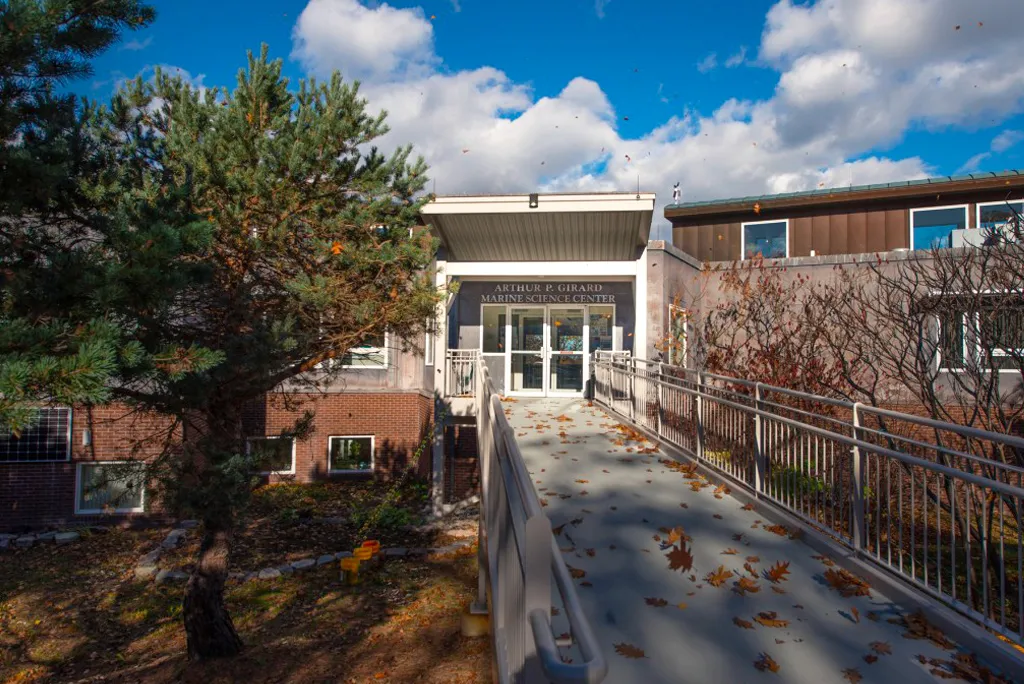
- The solar thermal wall is a black metal cladding on the south-facing wall, designed to preheat the air intake to the building, thereby reducing the need to heat the outdoor supply air.
- A 54-panel solar PV system, half the cost of which was covered by Scott Bordas of the Left Coast Fund, was added in 2019 and produces roughly 21 MWh of electricity annually.
- The research and teaching activities within the building requires large quantities of seawater to flow through the pools. While pumps are used to fill the outdoor storage tank, the system is gravity fed into and out of the building, saving energy use and cost.
- The many pumps and motors used within the building are made more efficient through the use of variable frequency drives.
- Floor drains are piped to the on-campus Wastewater Treatment Plant to ensure clean effluent to the Saco River.
- Radiant floor heating provides steady and efficient thermal comfort to the human and marine creature building occupants.
- Use of clerestory, a high section of wall containing a bank of windows, helps light the building’s interior.
Portland Campus for the Health Sciences Facilities
School of Pharmacy Building
Built in 2009, UNE’s School of Pharmacy building is one of two University buildings that have received silver level Leadership in Energy and Design (LEED) certification. In addition to several sustainable features incorporated into the structure, the construction of the building itself was performed using sustainable practices. For example, excavated material from the site was reused as clean fill on another local construction project, and 78% of the construction waste was recycled and diverted from landfills and incineration. Furthermore, the process of planning the building involved setting aside, as open, preserved conservation space, an area twice the size of the building’s footprint.
- Environmentally sustainable materials are used throughout, including Forest Stewardship Council certified wood, bamboo, and Lyptus wood.
- Recycled content is used in flooring tiles, ceiling tiles, carpeting, steel, counter tops, and office furniture.
- Occupancy sensors are used on lighting fixtures throughout the building to reduce electricity use.
- Highly efficient chilled beams are used to provide heating and cooling to offices, classrooms, and laboratories. (It was the first building in the state to utilize this technology.)
- An advanced mechanical system, called a heat wheel, recovers more than 80% of the heating and cooling from the air discharged outside the building.
- Energy-efficient fiberglass windows reduce heat loss.
- Water-efficient fixtures are used to reduce water use by 57% compared to a typical building.
- The roof overhang was designed to provide shade for the building’s windows at the peak of summer and to let the sun shine in on winter days to provide solar light and heat.
- Bricks for the exterior were made locally to minimize transportation of materials.
Oral Health Center
Built in 2013, UNE’s Oral Health Center serves as the clinical education center for UNE’s College of Dental Medicine. The building incorporates multiple energy-saving systems and products, from heat recovery units to high performance windows and below grade insulation, and features gravity-fed underground structures that capture stormwater and gradually release it below ground level.
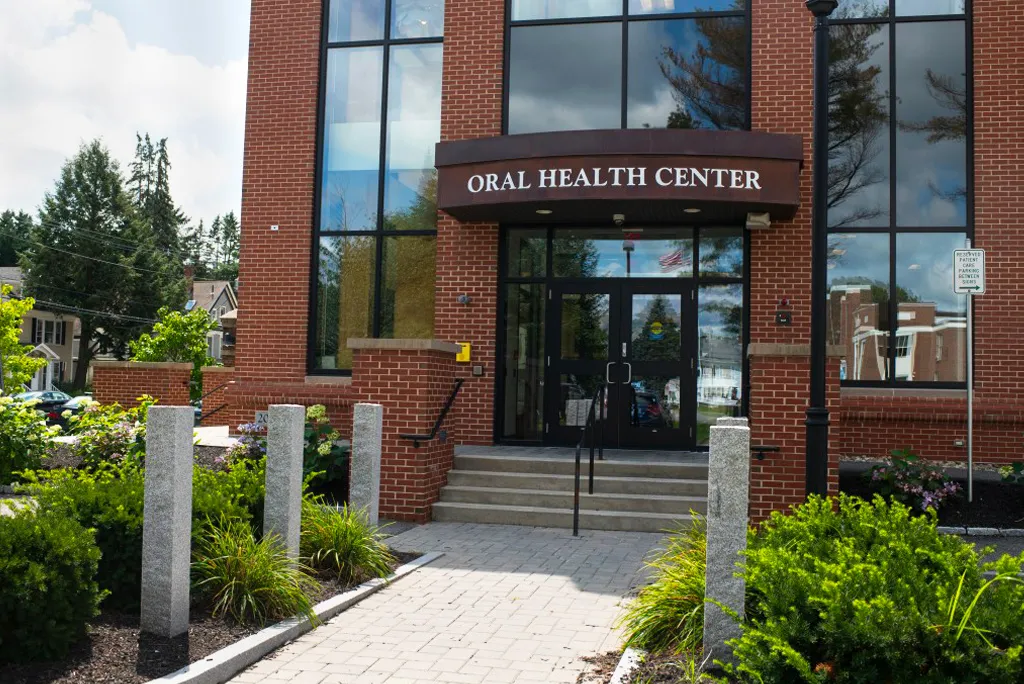
- Stormwater runoff is treated on campus through the use of drywells, reducing impact on the municipal stormwater system.
- Insulation below grade improves heating system efficiency and thermal comfort for building occupants.
- High-performance windows with low-e glass reduces thermal loss and gain, saving energy on heating and cooling.
- High-efficiency mechanical systems, including condensing boilers, variable frequency drives on motors and pumps, and heat recovery units contribute to operational energy savings.
- Low-flow plumbing fixtures contribute to water conservation efforts.
Harold and Bibby Alfond Center for Health Sciences
The Harold and Bibby Alfond Center for Health Sciences (HBACHS) is a 110,000-square-foot custom-built, state-of-the-art facility that serves as home to UNE’s College of Osteopathic Medicine as well as a hub of interprofessional practice utilized by all of UNE’s health professions programs. HBACHS features energy-efficient windows and mechanical systems, including water-source heat pumps, and low-flow plumbing fixtures. The building exemplifies carbon-conscious construction, from its use of materials that require lower levels of carbon in the manufacturing process to its parking lot that provides electric charging to a fifth of all parking spots.
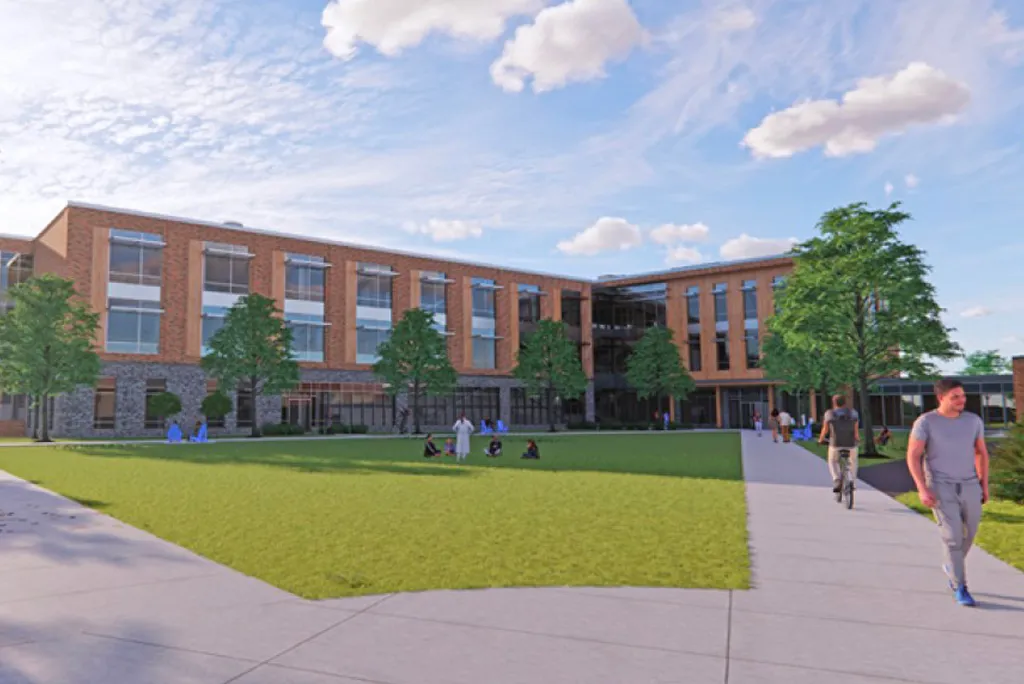
- Mass timber, specifically cross-laminated timber, will be used in roughly 40% of the building to reduce structural concrete and interior finish materials. (Use of mass timber lowers the embodied carbon of a structure and is aesthetically pleasing so further finish materials aren’t necessary.)
- Polished concrete slabs will replace finished flooring to reduce the embodied carbon in the construction process and reduce the equipment and chemicals needed for cleaning carpets and tile.
- Daylight harvesting and lighting controls on 100% LED lighting will save electricity.
- Water-source heat pumps will be used for heating the building. (These are more efficient than air-source heat pumps because heat transfer through water is more stable.)
- Energy efficiency of the mechanical systems will be acheived through the use of variable frequency drives, energy recovery units, and Automated Logic building controls.
- High-performance windows with low-e glass will reduce thermal loss and gain, saving energy on heating and cooling. Additionally the solar shades will prevent excessive thermal gain.
- Low-flow plumbing fixtures will contribute to water conservation efforts and have become standard in UNE building practices.
- The accompanying parking lot will be equipped with 20% of the spaces capable of charging electric vehicles, through a combination of level 2 chargers and 120v outlets.

